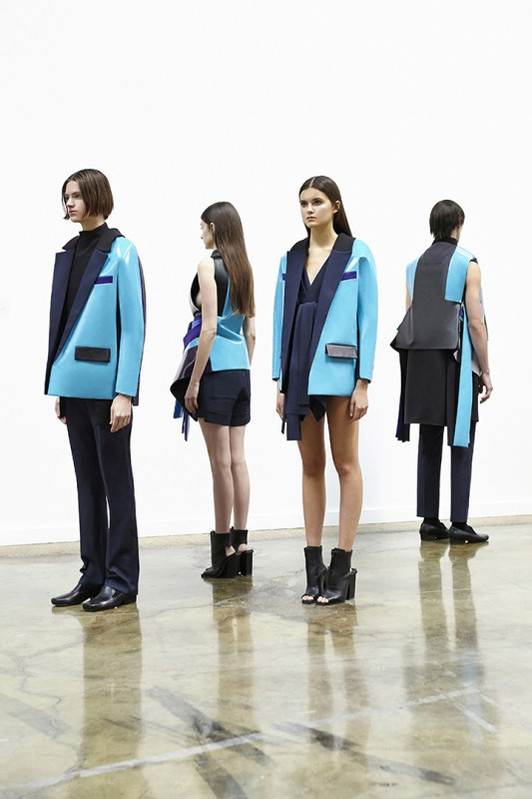NOTION MAGAZINE // 04.05.16 // ARE GENDER-NEUTRAL COLLECTIONS FOR THE CUSTOMER?
June 16, 2016If high-street brands are serious about gender-neutral fashion, their designs should be too.
Gender neutral fashion is becoming more and more popular. Companies such as Zara are adding “gender-neutral” collections into their high-street stores, and everyday online stores such as Gender Free World are popping up, catering to the ever more visible Trans and Agender communities; but isn’t it just putting a boxy, jumper-shaped blanket over the issue of what we feel comfortable with wearing?
Other “fast-fashion stores” like H&M also seem to just be re-developing simple unisex clothing patterns, then selling it off as a new idea. Similarly, if you look at retail giants like John Lewis and Jaycotts that sell the patterns in question, you will see the similarity in the silhouettes; block colours and lack of structure.
Is it too pessimistic to assume that this is just an exploitative ploy motivated by financial gain, or are these brands genuinely passionate about promoting positive body image?
Fortunately society is moving towards a point where we have the freedom to wear what we want, with no regards to the gender label on the garment. For example, I have known men to wear women’s skinny jeans for years because they fit better, and similarly have known women who wear men’s t-shirts for a more relaxed fit, while some men favour slimmer fitting tees that they may have been unable to find in ‘menswear’ shops. Why are high-street stores producing boxy silhouettes made out of cotton-jersey and seeming to simply extending on their already existing sportswear lines? If there is a gap in the market, this is an incredible opportunity to push the idea and look at selling a variety of options for that customer.
Politically, gender-neutral clothing lines are attractive, potentially lucrative ideas. Unfortunately some fast fashion retailers fail to put much thought into their versions of this new progression, and this is where my issue lies. Oversized jumpers and sweatpants don’t appear to contribute to this idea, but instead rely upon easily manufactured garments for a high gross profit. For high street stores with many loyal customers, it seems as though they have taken advantage of an already sensitive situation. These clothes hide the human form, and if you are trying to sell to such groups as the Trans or Agender community, you should come up with a product that’s not just for going to the gym, or hiding your figure from the public. Gender isn’t what is on the outside, but how you identify yourself holistically.
However it’s all not all bad, and some companies such as Selfridges, are actually making an effort to make genuine ‘gender-neutral’ fashion. What Selfridges did correctly for its Agender department and concept store, was do extensive research; they collected different items from a worldwide selection of designers to create a well-rounded concept to advertise to the public. On top of this, they also commissioned uni-sex brand Toogood, who has designed shop spaces for Alexander McQueen and Comme des Garçons, making that section of the store feel unique, desirable to visit and above all, treated like it would do any other new department.
Similarly, Louis Vuitton’s Spring Summer 2016 collection is a prime example of how to feel comfortable with our choices no matter what side of the store we shop in. In the campaign imagery, we see Jaden Smith dressed in this season’s womenswear collection. While people automatically labelled it “gender-queer” it’s an examples of how mainstream society can put something they don’t fully understand into the “LGBT Box.” Although Jaden Smith doesn’t identify as a woman, as is indicated by his hair, make-up, and posing choices, the campaign managed to demonstrate the ways in which clothing allows one to assume both male and female silhouettes. Proving that even when our first impression is questioned, it is about how you identify personally that has the final say.
There are also some stores that work as “unisex” as well. For example, designer Rad Hourani, who instead of making separate collections, creates “clothes for everyone”, but with colour palettes and panels that change your silhouette depending on how it’s styled on the human form. Isn’t this a more respectable representation of “gender-neutral” clothing than the easy, ill-fitting approach taken by the high-street brands?
If stores had fewer guidelines for what gender-appropriate outfits are, imagine the possibilities of what people would come up with, without having to feel subject to gender-selected clothing. Gender-neutral clothing has the potential to change the way we see, wear and experience fashion but until designers innovate outside of the confines of gender, it wont have the impact on society it deserves.






